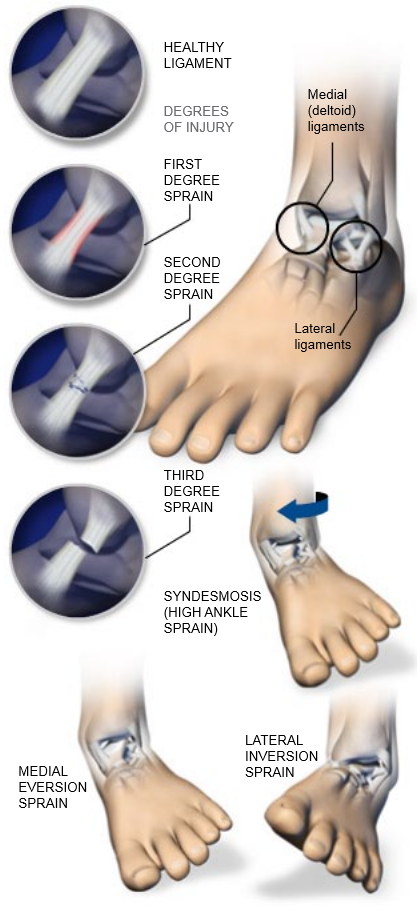Overview
An ankle sprain occurs when one or more ligaments – fibrous bands of tissue that provide stability to the joint – are stretched or torn from excessive force such as a sudden twisting during sports, stepping on an uneven surface, or a blow to the ankle.

Types of Sprains: Lateral Inversion
Over 85% of all ankle sprains occur when the foot rolls outward (inversion), injuring the ligaments on the lateral, or outside, of the ankle. The anterior talofibular is the most commonly injured ligament.
Types of Sprains: Medial Eversion
Occurs when the foot rolls inward (eversion), injuring the ligaments on the medial, or inside, of the ankle.
Types of Sprains: Syndesmosis (High Ankle)
The least common of all ankle sprains, this injury occurs in the upper part of the ankle when the foot rolls inward, accompanied by internal rotation of the tibia. It most often occurs in contact sports.
First Degree Sprains
Ankle sprains are generally “graded” according to the extent of injury: A first degree sprain is an injury in which one or more ligaments are stretched, accompanied by mild pain, bruising, inflammation, difficulty walking, and tenderness.
Second Degree Sprains
A second degree sprain occurs when one or more ligaments are partially torn, producing moderate pain and disability, bruising, inflammation, and the inability to bear weight.
Third Degree Sprains
A third degree sprain is an injury in which one or more ligaments are completely torn, resulting in severe pain and swelling, bruising, joint instability, and loss of function.
Treatment
Acute ankle sprains should be treated with RICE – rest, ice, compression, and elevation – and non-steroidal anti-inflammatory drugs to decrease swelling and pain. Depending on the degree of injury, a brace, cast or walking boot may be needed. Early rehabilitation with home exercise or formal physical therapy can improve range of motion and speed healing.
